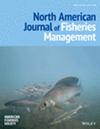Does release size into net‐pens affect survival of captively reared juvenile endangered suckers in Upper Klamath Lake?
IF 1.4
4区 农林科学
Q3 FISHERIES
引用次数: 0
Abstract
Abstract Objective High juvenile mortality prevents recruitment into the adult populations of endangered Shortnose Sucker Chasmistes brevirostris and Lost River Sucker Deltistes luxatus in Upper Klamath Lake, Oregon. To address the lack of recruitment, the U.S. Fish and Wildlife Service implemented the Sucker Assisted Rearing Program (SARP). Managers developing the rearing program lack information about how length at release relates to survival. To determine how initial length affects survival of captively reared juvenile suckers, we introduced juvenile suckers from the SARP into three net‐pens in Upper Klamath Lake. Methods The juvenile suckers ranged from 102 to 284 mm standard length, and each fish was tagged with a passive integrated transponder (PIT) tag. Fish were monitored continuously by PIT antennas and mortality was inferred when movements ceased. Result Estimated survival over 57 days was high in all net‐pens (0.79–1.00) and remained high at two net‐pens for 76 and 86 days. Adjusted survival curves resulting from a stratified Cox model with standard length as a covariate, indicated that length positively influenced predicted survival by as much as 41% at one site. During the study, pH and dissolved oxygen regularly exceeded no‐effect thresholds at two sites and briefly reached lethal thresholds at the same two sites but did not coincide with the observed mortalities. Slower growth and the lowest survival were observed at the third site, where water quality never exceeded thresholds. Conclusion A larger release size and the location of the net‐pen can improve the survivability of juvenile suckers in net‐pens in Upper Klamath Lake.上克拉马斯湖圈养的濒危吸盘鱼幼鱼的放生大小是否会影响其生存?
摘要目的俄勒冈州上克拉马斯湖濒危物种短鼻吸鱼Chasmistes brevirostris和Lost River Sucker Deltistes luxatus幼鱼的高死亡率阻碍了它们进入成年种群。为了解决招募不足的问题,美国鱼类和野生动物管理局实施了吸盘辅助饲养计划(SARP)。开发饲养计划的管理者缺乏关于放生长度与生存的关系的信息。为了确定初始长度如何影响人工饲养的吸盘鱼幼鱼的生存,我们将来自SARP的吸盘鱼幼鱼引入上克拉马斯湖的三个网栏中。方法采用标准长度为102 ~ 284 mm的幼鱼吸盘,每条鱼均采用被动式集成应答器(PIT)标签。由PIT天线连续监测鱼类,并在运动停止时推断死亡率。结果57天的估计存活率在所有净栏中都很高(0.79-1.00),在76天和86天的两个净栏中仍然很高。以标准长度为协变量的分层Cox模型得出的调整生存曲线表明,在一个位点,长度对预测生存的影响高达41%。在研究期间,两个地点的pH值和溶解氧定期超过无影响阈值,并在同一两个地点短暂达到致死阈值,但与观察到的死亡率不一致。在水质从未超过阈值的第三个地点观察到较慢的生长和最低的存活率。结论加大放生规模和设置网栏可以提高上克拉马斯湖网栏中吸盘鱼幼鱼的存活率。
本文章由计算机程序翻译,如有差异,请以英文原文为准。
求助全文
约1分钟内获得全文
求助全文
来源期刊
CiteScore
2.60
自引率
18.20%
发文量
118
审稿时长
2 months
期刊介绍:
The North American Journal of Fisheries Management promotes communication among fishery managers with an emphasis on North America, and addresses the maintenance, enhancement, and allocation of fisheries resources. It chronicles the development of practical monitoring and management programs for finfish and exploitable shellfish in marine and freshwater environments.
Contributions relate to the management of fish populations, habitats, and users to protect and enhance fish and fishery resources for societal benefits. Case histories of successes, failures, and effects of fisheries programs help convey practical management experience to others.

 求助内容:
求助内容: 应助结果提醒方式:
应助结果提醒方式:


